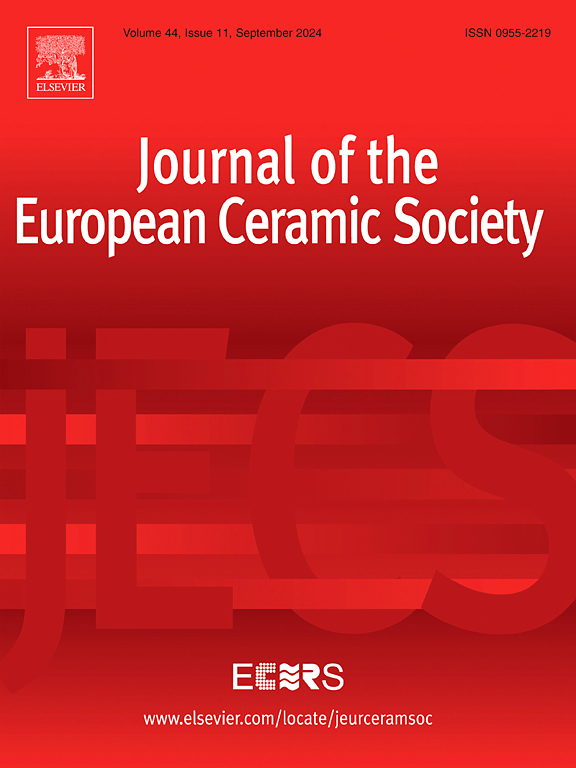溶胶-凝胶法制备SiC改性(Ti, Zr, Hf)C多相陶瓷的演化机理及性能研究
IF 6.2
2区 材料科学
Q1 MATERIALS SCIENCE, CERAMICS
Journal of The European Ceramic Society
Pub Date : 2025-06-12
DOI:10.1016/j.jeurceramsoc.2025.117619
引用次数: 0
摘要
这项工作深入研究了从有机前驱体到致密的sic改性(Ti, Zr, Hf)C固溶体陶瓷的迷人转变。采用创新的溶胶-凝胶工艺结合碳热还原法制备纳米晶粉体,再通过火花等离子烧结(SPS)法制备多相陶瓷。结果表明,硅烷醇盐的加入有利于形成坚固的多相凝胶网络,有利于氧化物中间体(如ZrSiO4, HfSiO4)的形成,加速相变,并通过包封Ti/Zr/Hf化合物来抑制晶粒粗化,同时强化晶界。前驱体在1400℃热解后,逐渐演化为高结晶、中等熵的固溶体。最佳烧结复合材料的相对密度为97.8% %,开孔率为0.4 %。通过诱导晶格畸变和SiC的细晶强化作用,提高了合金的力学性能。纳米压痕测试表明,(Ti, Zr, Hf)C-SiC复合材料的硬度和弹性模量分别达到22.39 GPa和342.78 GPa。本文章由计算机程序翻译,如有差异,请以英文原文为准。
Insight into the evolution mechanism and properties of SiC modified (Ti, Zr, Hf)C multi-phase ceramics synthesized via the sol-gel method
This work delves into the fascinating transformation from organic precursors to dense SiC-modified (Ti, Zr, Hf)C solid solution ceramics. Nanocrystalline powder was crafted through an innovative sol-gel process coupled with carbothermal reduction, followed by spark plasma sintering (SPS) to obtain the multi-phase ceramics. The results indicate that the addition of silicone alkoxide is required for forming a robust multi-phase gel network, which facilitates the formation of oxide intermediates (e.g., ZrSiO4, HfSiO4), accelerates phase transformation, and inhibits grain from coarsening by encapsulating Ti/Zr/Hf compounds while reinforcing grain boundaries. After pyrolysis at 1400 °C, the precursors gradually evolved into a highly crystalline, medium-entropy solid solution. The optimal sintered composite achieves a relative density of 97.8 % and an open porosity of 0.4 %. The mechanical properties were improved by induced lattice distortion and effect of fine-grained strengthening with the incorporation of SiC. Nanoindentation tests reveal that the hardness and elastic modulus of the (Ti, Zr, Hf)C-SiC composite reach 22.39 GPa and 342.78 GPa, respectively.
求助全文
通过发布文献求助,成功后即可免费获取论文全文。
去求助
来源期刊

Journal of The European Ceramic Society
工程技术-材料科学:硅酸盐
CiteScore
10.70
自引率
12.30%
发文量
863
审稿时长
35 days
期刊介绍:
The Journal of the European Ceramic Society publishes the results of original research and reviews relating to ceramic materials. Papers of either an experimental or theoretical character will be welcomed on a fully international basis. The emphasis is on novel generic science concerning the relationships between processing, microstructure and properties of polycrystalline ceramics consolidated at high temperature. Papers may relate to any of the conventional categories of ceramic: structural, functional, traditional or composite. The central objective is to sustain a high standard of research quality by means of appropriate reviewing procedures.
 求助内容:
求助内容: 应助结果提醒方式:
应助结果提醒方式:


